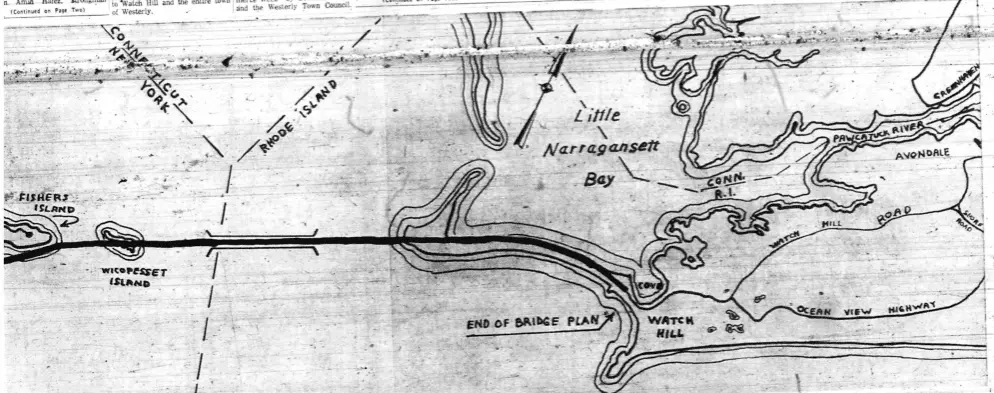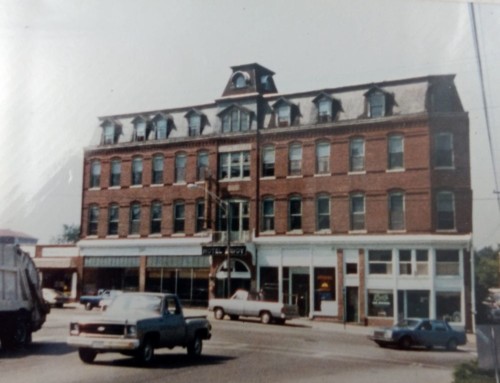Read Part 1 first.
There were many who strongly supported the idea that a bridge from Long Island would be beneficial for all parties. New York City Traffic Chief Henry A. Barnes was among the pro-bridge advocates, as he believed it would serve as a way to alleviate congestion in New York City.[18]
It was estimated that approximately 8,700 vehicles would use the bridge daily.[19] Another strong proponent of the bridge was Mrs. Eleanor F. Slater, a State Representative from Warwick, who formed and chaired a committee as part of the larger Tri-State Bridge Committee.[20]
While there were many who supported the potential crossing, there were just as many who opposed the concept. Rhode Island Governor John H. Chaffee was on record several times voicing his opposition to any bridge across Long Island Sound which would terminate in Rhode Island.[21]
The Fisher’s Island Development Corporation also vehemently disagreed with the plans, as it would have a negative impact on the landscape of the island.[22] Additionally, in October 1963, the Chamber of Commerce once again voiced their disapproval.[23]
The most vocal opponent to a bridge terminating in Watch Hill, however, was Mrs. Philip B. Eaton, the head of the Watch Hill Improvement Society.[24] Mrs. Eaton’s opposition group included members from the Misquamicut Club and the Watch Hill Yacht Club.[25] Resistance was so strong that some seasonal Watch Hill residents threatened to leave the community if a bridge was constructed.
The Westerly Sun noted that this would have significant negative consequences for the town, as many summer residents of Watch Hill paid a full year’s worth of taxes on their homes despite not using many public services, particularly local schools.[26] In spite of all this, some Westerly residents felt that the benefits to the local economy of a bridge outweighed the loss of Watch Hill residents.[27]
The 1963 proposal also designated Groton Long Point as an alternate terminus giving the bridge two potential New England entryways.[28] One hindrance to the bridge’s potential was that a 30-mile extension of the Long Island Expressway would be required, adding to the already heavy cost.[29] While there were several potential hang-ups that threatened to derail plans for a bridge over Long Island Sound, the project continued to move forward in 1963.
On October 9, the Sun published an article about the proposal, and with it, a map showing the prospective route.[30] The following month, the newspaper claimed there was significant discussion locally about the pros and cons of the plan with the bridge issue being covered by all types of media including newspapers, radio and television.[31] On November 26, 1963, Dr. Pavlo met with the Governors of New York, Connecticut and Rhode Island to start laying plans for financing the bridge.[32]
By February 1964, as opposition to the bridge grew, Mrs. Eaton offered what appeared to be a somewhat tenuous plan for Westbrook, Connecticut to serve as an alternative terminus for the bridge. Eaton and her group, now known as the Watch Hill Bridge Rejection Committee, claimed that they had an engineer (whose name they failed to provide) check the feasibility of using Westbrook as an endpoint and the engineer declared the notion sound.[33]
That same month, Groton Marine Conductor Clarence B. Sharp suggested a tunnel under Long Island Sound as an alternative to the costly bridge. The tunnel would extend from Orient Point to Rocky Neck, Connecticut. At only 10 miles long, the tunnel would ultimately cost about 1/3 of the projected price of the over-water bridge.[34]
Issues with the bridge proposition began to come to light in May 1964, when a three-man committee headed by real estate investor Edward McGowan was formed. McGowan claimed “previous engineering feasibility studies, conducted on speculation by private consultants, were “superficial” and had not covered many vital areas of engineering.”[35]
In June of that year, the Rhode Island Legislative Study Commission endorsed a proposal by the State of New York for the examination of the engineering and economic problems associated with building the bridge.[36] The study was slated to take 18 months and was funded by New York state.[37] As this examination got underway, the New York and Rhode Island commissions took a boat tour across the 23.4-mile route which the bridge was to cover.[38]
In August 1964, the Rhode Island Commission was informed that the bridge would be “completely feasible.” It was also suggested, however, that five to ten years of legislative and engineering work could be required before construction was to begin.[39]
By late 1964, references to the proposed bridge tapered off and aside from a mention on December 29, 1964, that the New York State Department had awarded two contracts totaling $88,000 for studies concerning the feasibility of the bridge, little mention was made of the project for several years.[40] While the exact cause of the proposal’s failure is not known, it was likely a combination of waning support, high price estimates, and questions regarding the structural integrity of such a project that led to its death.
The defeat of the 1963-64 endeavor was not the end. In 1979, a new proposal appeared in the State of New York which considered five prospective bridges across Long Island Sound. One of these bridges was a new Orient Point-Watch Hill span.[41] The project, initiated by New York Governor Hugh Carey, was projected to cost $1.4 billion and would provide employment for 18,000 people.
Perhaps the reason the proposal was considered despite several previous failures to get such a venture completed, was the revenue projection which suggested that by 1990, the bridge would generate between $22 and $27 billion in net revenue less than bond financing.[42] While this may have been cause for celebration for the pro-bridge camp, the prospects were still grim. In June 1979, the Sun noted that of the five proposed bridges, the Watch Hill crossing was the least favorable.[43]
Following in the footsteps of Gov. Chafee before him, Gov. J. Joseph Garrahy openly opposed the bridge, citing the cost and lack of interest from Rhode Islanders as his primary reasons.[44] Although originally projected to cost $1.4 billion, by June, the estimate had ballooned to $1.7 billion.[45] A random survey of Rhode Island residents found that 70% supported the bridge proposal, however, the procedure for conducting this survey was called into question, and it was largely felt that there was much less support in the state.[46]
By September 1979, the project was now expected to cost $2 billion. Shortly after this, the Westerly Sun reported that the status of the potential bridge was extremely unlikely.[47] Ultimately, it was found that a ferry would be preferable to a bridge. The Cross Sound Ferry began service in 1975, however, service was not extended to Watch Hill.[48]
Since 1979, the concept of a bridge crossing Long Island Sound has resurfaced from time to time. No proposal over the last forty years has advanced quite as far as the 1963 project, and although technological advances have made the construction of such a bridge more feasible, it is unlikely that a span across the Sound will come into existence any time in the near future. Despite this, there was a time, 55 years ago, when the project was a very real possibility.
[su_accordion class=””] [su_spoiler title=”Footnotes” open=”no” style=”default” icon=”plus” anchor=”” class=””]
- Utter, Charles W., “Orient Point to Rhode Island Bridge Creating Local Concern” Westerly Sun, 13 November 1963.
- “Tri-State Agency to Study Proposed Long Island Span” Westerly Sun, 16 August 1963.
- Utter, Charles W., “Orient Point to Rhode Island Bridge Creating Local Concern” Westerly Sun, 13 November 1963.
- Utter, Charles W., “Orient Point to Rhode Island Bridge Creating Local Concern” Westerly Sun, 13 November 1963 and “Rhode Island Committee Traces Course” Westerly Sun, 19 August 1964.
- Utter, Charles W., “Orient Point to Rhode Island Bridge Creating Local Concern” Westerly Sun, 13 November 1963.
- “Directors Firmly Opposed” Westerly Sun, 9 October 1963.
- Utter, Charles W., “Orient Point to Rhode Island Bridge Creating Local Concern” Westerly Sun, 13 November 1963.
- Utter, Charles W., “Orient Point to Rhode Island Bridge Creating Local Concern” Westerly Sun, 13 November 1963.
- Utter, Charles W., “Orient Point to Rhode Island Bridge Creating Local Concern” Westerly Sun, 13 November 1963.
- Utter, Charles W., “Orient Point to Rhode Island Bridge Creating Local Concern” Westerly Sun, 13 November 1963.
- Utter, Charles W., “Orient Point to Rhode Island Bridge Creating Local Concern” Westerly Sun, 13 November 1963.
- New York Department of Transportation, “Long Island Sound Crossing Feasibility Study” December 2017, pg. 7.
- “Bridge Project Ends Here” Westerly Sun, 9 October 1963.
- Utter, Charles W., “Orient Point to Rhode Island Bridge Creating Local Concern” Westerly Sun, 13 November 1963.
- Utter, Charles W., “Orient Point to Rhode Island Bridge Creating Local Concern” Westerly Sun, 13 November 1963.
- “Westbrook, Conn., Proposed Terminus” Westerly Sun, 3 February 1964.
- “A Tunnel Instead of Span” Westerly Sun, 3 February 1964.
- “L. I. BRIDGE STUDY STARTED AFRESH; Earlier Plans for 23.4‐Mile Span Across the Sound Are Called ‘Superficial’; A WIDER REPORT SOUGHT; Committee Governor Named Holds First Meeting on Long‐Sought Project” New York Times, 23 May 1964.
- “Full Survey of L.I. Span Plan Backed” Westerly Sun, 23 June 1964.
- “Full Survey of L.I. Span Plan Backed” Westerly Sun, 23 June 1964.
- “Rhode Island Committee Traces Course” Westerly Sun, 19 August 1964.
- “Rhode Island Committee Traces Course” Westerly Sun, 19 August 1964.
- “N.Y. Awards Contracts for Studies” Westerly Sun, 29 December 1964.
- New York Department of Transportation, “Long Island Sound Crossing Feasibility Study” December 2017, pg. 8.
- New York Department of Transportation, “Long Island Sound Crossing Feasibility Study” December 2017, pg. 8.
- Coyle, Pat,”RI-LI Bridge Unlikely” Westerly Sun, 28 June 1979.
- Coyle, Pat,”RI-LI Bridge Unlikely” Westerly Sun, 28 June 1979.
- Coyle, Pat,”RI-LI Bridge Unlikely” Westerly Sun, 28 June 1979.
- Coyle, Pat,”RI-LI Bridge Unlikely” Westerly Sun, 28 June 1979.
- Coyle, Pat, “Watch Hill-Orient Point Bridge Seen Unfavorable,” Westerly Sun, 21 September 1979.
- Finn, Lisa, “New Ferry Added to Cross Sound Ferry Fleet” Patch.com, 3 September 2016.
[/su_spoiler] [/su_accordion]






